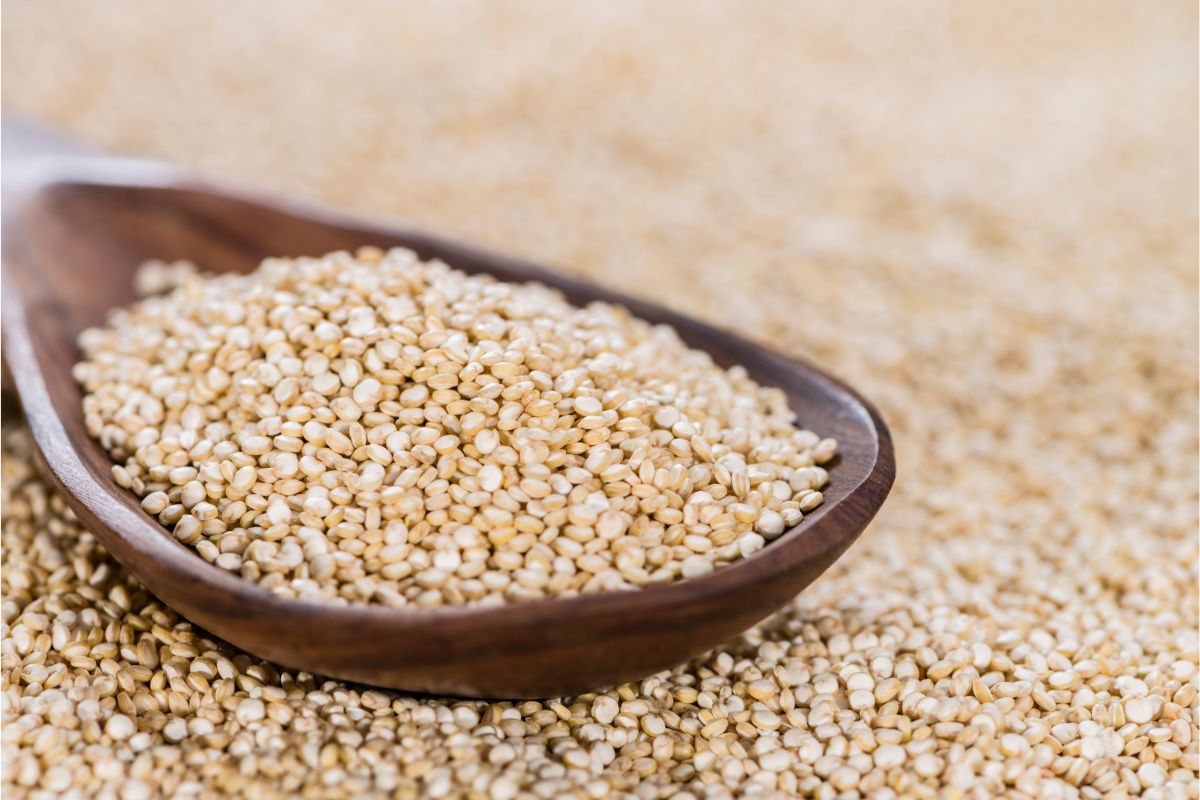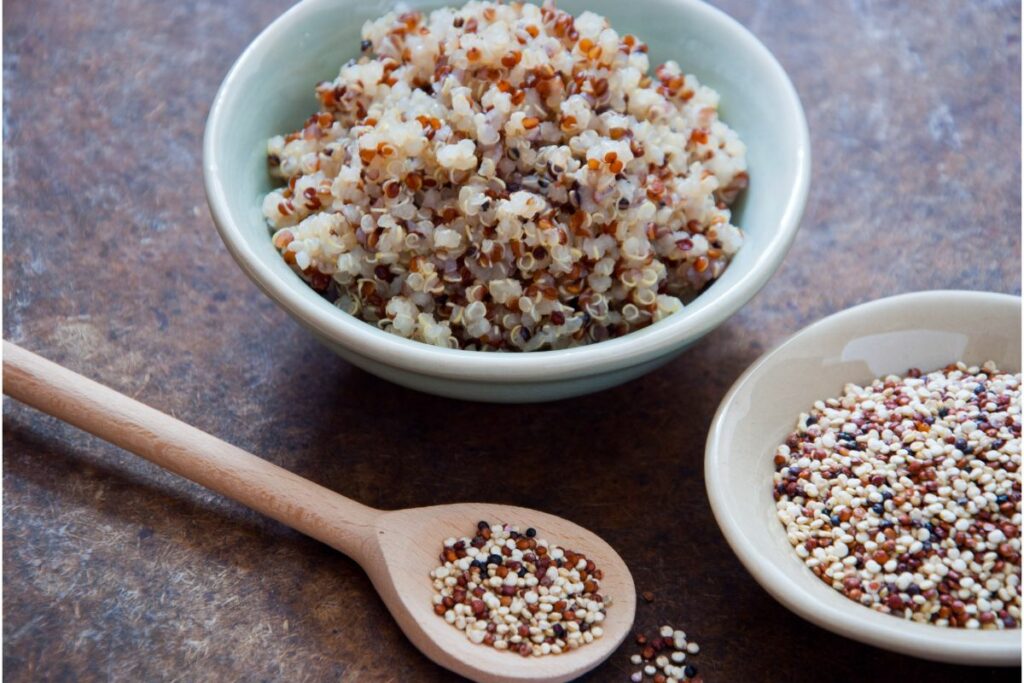If you’re on a quest to improve your daily diet, you’ve probably heard of superfoods like Quinoa. Quinoa is one of the most nutritionally diverse and versatile seeds on the planet, and with a subtle taste, it’s one of the most versatile to add to your diet.
If you’re still skeptical about the benefits of Quinoa and need some convincing, we’re here to help. In this article, we’ll be walking you through the anti-inflammatory properties of Quinoa, how they work, and what other benefits you can expect to gain from this exceptional seed.
What Is Quinoa?
Quinoa, pronounced ‘keen-wah’, is an ancient edible seed that comes in white, yellow, red, and black.
The quinoa plant has been cultivated for approximately 5,000 years, and once the seeds are harvested, they go through a process that removes their bitter compound (saponins), which also acts as a pesticide.
Although there are many different ways to harvest quinoa, it’s usually harvested by hand depending on the maturity of the seed.
Quinoa is native to South America, and in recent years, its been hailed a ‘superfood’ due to its impressive nutritional content. Although many people think quinoa is a grain, it’s actually not.
Quinoa is what’s known as a ‘pseudo-grain’, because it has a similar nutritional profile and is eaten in the same ways as most cereal grains.
Quinoa has always been a pretty unique and impressive seed; when it was first grown in the Andes, it was called ‘the mother grain’ and held to sacred standards.
Although it’s still grown all around the world, quinoa is mainly produced in Peru and Bolivia. Quinoa remained somewhat of a secret to the rest of the world until it became popular in the West in the last decade.
Quinoa: Nutritional Profile
Quinoa never became popular in the West due to its flavors or aromas – its nutritional profile was what took its popularity to new heights, and made it a staple in the diet of fitness fanatics and health-conscious individuals.
To understand why Quinoa is so popular, we’ll take a look at its impressive nutritional profile below.
The average serving of cooking Quinoa (100 grams) contains the following:
- 1.9 grams of fat
- 2.8 grams of fiber
- 0.9 grams of sugar
- 21.3 grams of carbs
- 4.4 grams of protein
- 72% water
- 120 calories
What makes Quinoa so popular, though, is its vitamin and mineral content. Quinoa provides significantly more antioxidants and minerals than most other grains.
Here are some of the most popular:
- Iron
- Magnesium
- Folate
- Copper
- Phosphorus
- Manganese
- Zinc
Quinoa is also a good source of several plant compounds that contribute to both its flavor profile and its health benefits. Some of the most common plant compounds found in Quinoa include:
- Phytic acid
- Oxalates
- Squalene
- Quercetin
- Saponin
- Kaempferol
Is Quinoa Inflammatory?
Quinoa is a well-known healthy seed containing many vitamins, minerals, and antioxidants. Quinoa is not inflammatory, in fact, it’s the opposite.
Quinoa contains a large number of anti-inflammatory phytochemicals and phytonutrients, namely Saponins, that have powerful antioxidant and anti-inflammatory properties.
Although some Saponins are removed in the harvesting and production process, many remain.
Saponins are a type of chemical compound found in many seeds, herbs, and vegetables, and they’re even present in sea cucumbers and starfish.
These natural compounds can be found in all the cells of legume plants, and one study discovered that they could reduce the production of inflammatory compounds in isolated cells by 25-90%.
Other studies have explored the benefits of Saponins on the body and found that they may be able to lower the blood glucose response, decrease the risk of cancer, reduce blood lipids, and prevent inflammation in the body.
The consumption of saponins may also reduce the need for dental care and may inhibit platelet aggregation in the body.
Although Saponins play a big role in Quinoa’s anti-inflammatory properties, these seeds also contain large amounts of phenolic acid and vitamin E which many experts believe reduce inflammation in the body and promote healthier gut bacteria.
This may make Quinoa the ideal addition to your diet if you want to prevent disease, reduce inflammation in the body, and even prevent obesity.
The Health Benefits Of Quinoa

As well as reducing inflammation in the body, Quinoa also has another number of impressive health benefits, including:
Improving Blood Sugar Control
Evidence suggests that this powerful whole grain may be linked to a reduced risk of type 2 diabetes, and better blood sugar control.
Although most of this research is exclusive to animal studies, it has shown promising results, suggesting that it could be an effective treatment in humans, too.
Contains Complete Proteins
Impressively, this powerful wholegrain also contains complete proteins. Complete proteins are a form of protein that contains all nine of the amino acids needed in humans.
Although almost all animal proteins are complete, most plant-based proteins are not; however, Quinoa is an impressive exception.
If you’re a vegan or vegetarian, you can reap the benefits of complete proteins by simply adding Quinoa to your diet.
May Improve Metabolic Health
If you have high blood lipids, you may benefit from adding Quinoa to your diet.
Studies have found that Quinoa may be able to lower the total cholesterol and LDL cholesterol levels in our bodies if consumed regularly and consistently.
Although the results were significant, there was a notable drop in levels which, although preliminary, are promising.
Are There Any Risks?
Quinoa is safe for human consumption, and it’s actually an incredibly healthy food to add to your diet. However, like other foods, Quinoa does contain small amounts of anti-nutrients.
Antinutrients such as oxalates and phytic acid can be found in trace amounts in Quinoa, however, these are usually well-tolerated by those with a healthy diet, and there’s no research to suggest that consuming them in Quinoa presents any health risk.
How To Eat Quinoa
Want to reap the benefits of this incredible seed? It’s never been easier to incorporate Quinoa into your diet.
Whatever your preferences, there are many ways to up your daily intake of this nutritional powerhouse. Here are some of the most common ways to enjoy Quinoa in your diet:
- Adding it to smoothies
- Enjoying it with salad
- Adding it to oatmeal
- Incorporating it into soups
- Using it as a replacement for rice
- Adding it to desserts
- Using it to make homemade Quinoa energy bars
Most people prefer to eat Quinoa as a side dish – it goes well with almost any meal, and thanks to its subtle taste, it can be eaten alongside a number of foods, both meat and plant-based.
Final Thoughts
Although Quinoa hasn’t become a popular addition to the Western diet until recently, it’s now one of the most popular superfoods in the world.
Whether you want more protein, nutrients, to decrease your risk of disease or high blood pressure, Quinoa can be a fantastic addition to your daily diet.
Thanks to its subtle taste, it’s also an incredibly versatile food that can be enjoyed in a number of ways!








